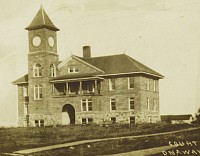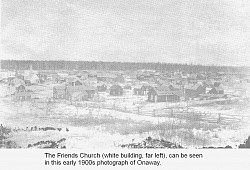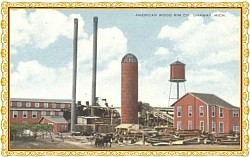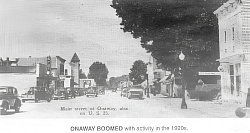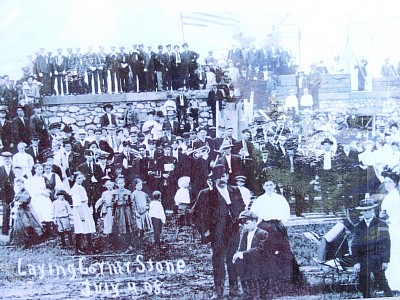The History of Onaway
Onaway, Michigan: The First 50 Years
Taken from the Onaway Outlook July, 1999; Used with the Permission of the Presque Isle Advance
written by Richard Lamb
Article Copyright 1999 Presque Isle Advance
Onaway's first 50 years were marked by dramatic highs and equally stunning lows. A humble start preceded rapid growth and world recognition. Prosperity came first, then came mass unemployment as the area's lifeblood pulsed no more.....
…(Onaway’s history cont.)
In the summer of 1881, what is now Onaway was no more than a wide place in the trail. A few years earlier, the country was still wilderness filled with timber, some farmland, plenty of wildlife and the promise of things to come. Lines of unbroken trees for many miles defined the territory.
In the 1880s, settlers stormed to the area in droves, drawn by the opportunities in the surrounding natural resources. Strong, hardworking men came to the area, then sent for their families. They traveled in groups from the same country, with family, or alone as they pioneered this unexplored area of northern Michigan. With no roads, no schools and no houses, the wilderness beckoned the hearty in search of their fortune. Settlers obtained most of their basic supplies from Cheboygan, some 35 miles to the north.
Two innovators in the area, Merritt Chandler and his brother-in-law Thomas Shaw, arrived around 1880, and with them came organization and progress.
Shaw was born in Ohio in 1842, the son of a saw mill operator. His parents moved to Michigan where young Thomas attended the best schools and colleges available at the time. Shaw was a Quaker and a graduate of a theological course in one of the colleges he attended. He studied law, taught school in the winter, and worked on the farm in the summer.
Seeking a more healthful occupation and climate, Shaw landed in the area in 1881 at age 39. He bought 300 acres of land, which took in the south half of what is now the City of Onaway. He established a settlement which became known to others venturing through as Shaw's Post Office. Shaw was the community's first school teacher (with seven pupils) as well as its first Postmaster (from 1883 to 1893). He operated the area's first hotel and served in those days as township supervisor, township clerk, justice of the peace, and county school commissioner. Soon, though, another dominant figure would move north.
Merritt Chandler was born near Adrian in 1843 and was educated at Raisin Valley Seminary, a well known Quaker Institution. He was very well educated for his day and time. Chandler started out on his own at age 26 as a lumberman in Cass County. In 1875 he transferred his timber operations to what is now the City of Cheboygan. Chandler, who built his home just across the street and a little farther west of Shaw's home, dreamed of a clean, quiet village where no drink would be sold and everyone would be at peace with his neighbors.
He plotted a piece of ground in six blocks between [what is now] Main Street and Lynn Street. He hoped it soon would become a peaceful city where everyone was sober and happy. The ban of the sale of liquor was written into every transfer of property. Shaw and Chandler were related by marriage and belonged to the same church, but were of different political affiliations. They opposed one another from the start.
Soon roads were built, mills sprung up to process timber, and farmers soon followed to plant cleared fields where vast forests of virgin timber once stood. Chandler platted the village in 1886, and with his wife named it “Onaiweh,” meaning “awake” from Henry Wadsworth Longfellow's poem “Hiawatha”. The poem spoke romantically of northern Michigan and Wisconsin Indian lore.
With the arrival of the first freight train on March 28, 1898, as reported by the Cheboygan Democrat, a new link to the world came about.
In 1899, Onaway, as it was now called, became incorporated as a village. After the Detroit and Mackinaw Railroad linked Onaway to Tower, the population rose from around 500 in 1899 to some 1200 two years later.
In an effort to speed development to remote areas, the federal and state governments worked on improving transportation in northern Michigan. An 1859 law passed by the Michigan Legislature said that builders of state roads would be paid in vacant state-owned swamp lands. In 1873, the Swamp Land Board of Control recommended building what was later called the Presque Isle and Little Traverse Road.
Chandler earned 40,000 acres of land from the state as a road builder. He built the road from the harbor of Presque Isle to Petoskey and the Black Lake to southern Allis Township—some 70 miles of road in all.
Chandler told of his optimism regarding the future of Onaway in an interview published in the Aplena Evening Echo in 1900. “Yes, sir Onaway is growing up,” he told the newspaper. “Last year was a record breaker in the number of business blocks and homes erected and more will be built this year than last. There are no idle hands in Onaway. “We have 150,000 acres of the finest hard wood in the world, around Onaway, and at the rate it is being manufactured now, it will las 20 years or 15 years at least with an increased demand every year.”
He predicted success after the land was timbered out. “As the timber goes, it clears up the richest farming land in Michigan. Our soil is a sandy and clay loam and will not need fertilizing for years to come. It is unsurpassed for wheat and will produce three or four crops of oats in succession and the last crop will be better than the first.” He told the Alpena Evening Echo. A population of 5,000 could be expected, according to the city founder.
By 1903, the population grew to some 3,000 people and Onaway became Presque Isle County's largest city. Activity and potential for growth ran wild in the town.
Anticipating more growth, and in hopes of securing the county seat, Chandler built and donated a building for this purpose. His monument to expected expansion stands today as the Onaway Courthouse. Although court was held in the building for several years, the county seat remained in Rogers City. A try at breaking off from Presque Isle County to form “Forest County” started. The new county was to include several townships from Presque Isle and Cheboygan Counties.
Although the local effort was well organized and drew wide support, the battle was lost as the bill went down at the state level in 1911.
Small town politics made for disagreements and a halt to some progress. In the city's first 20 years, there were two newspapers, four lawyers, four doctors and three large hotels. Citizens also enjoyed 17 saloons, two bakeries and worshiped in nine churches. Democrats and Republicans lived in Onaway. Mill owners wanted one thing while the towns people had other opinions.
The town finally got together in 1920 to do the first street paving.
Entertainment could be had at the local opera house, at one of many prize fights or at the horse racing track. For a time during the Prohibition years, Presque Isle County was dry and Cheboygan County was wet, making the road between Tower and Onaway one of the most traveled roads in the area.
Wildfires were a constant threat to the way of life in the lumbering era. Piling of brush and sometimes dry conditions increased the chances of a disastrous fire.
One such fire occurred in 1907, destroying poles valued at $12,000 from the Lobdell and Bailey Company and costing the Fletcher Paper Company More than $10,000 in losses. Tales were told of narrow escapes from the blaze as wind shifted, sending the flames around homes.
With seven lumber mills already flourishing, the American Wood Rim Company relocated its factory to Onaway and became the mainstay of employment in the community around the turn of the century.The plant made wooden automobile steering wheels and wooden bike rims. It is estimated they were the largest wooden steering wheel manufacturer in the world in the 1920s.
The plant and its grounds covered 44 acres. Published estimates of employment vary, some saying some 800 people worked at the plant.
Ten miles of railroad track, called the Onaway and North Michigan Railway, were owned by the company.
It was a good time to be in business in Onaway. Things were looking up.
But the fortunes of the company and Onaway changed in one fateful day in January, 1926.
According F.F. Stutesman, editor of the Onaway Outlook, a dramatic fire at the area's largest employer brought the city to its knees:
“One crisp morning in January, 1926, the fire whistle blew and as is the custom, everyone rushed to the door and window to find out where the fire was. In the west they saw huge clouds of black smoke rising from the Lobdell and Bailey mills. Stores, homes, offices were abandoned, and every citizen went to the fire. By nightfall, Onaway's backbone was broken”
Within a matter of days, a mass exodus left the town almost silent, as Stutesman described:
“By the end of the week, thousands of transient laborers had left the city to seek employment elsewhere. Merchants took stock of their resources. Folks left the city in such a hurry that they forgot to pay their bills. That weekend was a decision time for many a resident.
“The Lobdell Company soon announced they would move their plant to Alma and invited those of their employees that wanted to, to move there with them. Many of them did.” E.J. Lobdell, president of the company, moved the operations to a former World War I truck manufacturing plant downstate. The new plant would employ 300 workers.
Stutesman wrote the city was broken by the loss:
“After inventory, the city fathers found themselves with a heavy debt, with no credit, and not much means of collecting taxes. A valuation of $1.5 million had dropped to $200,000. They could levy the tax, but no one would pay.
“Then Onaway, with all its empty houses, became a natural home for squatters that were driven out of our larger cities. They didn't need to ask to rent a house, they just moved in, rent free. Good homes were sold for $40 and $50 and the best could be bought for a couple hundred dollars.”
Another blow to the city's fortunes came in 1932 with the closing of the Onaway State Savings Bank.
The city suffered, but did not succumb. In 1930, Fred Weingart became mayor and, under his leadership, the city began to whittle down its indebtedness and start a comeback. Public expenditures were reduced to the minimum possible. The city clerk, city manager, street commissioner, and water works superintendent became one and the same person.
As the optimistic Stutesman told in 1948, the city did not fold. He wrote:
“The people of Onaway did not give up. They rolled up their sleeves, tightened their belts and went to work. During the W.P.A. Days, full advantage was taken of the government money and the city cleaned up. In 1940, at the first scavenger sale, the people bought back the property that had gone to the state for taxes. From this date the comeback was rapid.
“Now Onaway has most services available, some plants that give employment and resort facilities which have been improved to accommodate summer and winter visitors.
“Onaway is the best little town in the State of Michigan.”
There now [1999] are a number of small plants that provide some employment. There are two financial institutions, an airport, and many other services one would expect to find in a community this size.
Resort facilities have been improved and are now enjoyed by thousands of summer visitors each year. There is city water and talk of constructing a municipal sewer system [now in place]. The clean- up process continues.
This year [1999], Onaway is 100. It has had a somewhat turbulent life, growing from a dense forest to a prosperous city to a ghost town to another prosperous, though smaller community, built on a solid foundation.
Bracketed text [ ] added by transcriber-2009
Post Script (added by transcriber 2009)
Today, the old courthouse has been restored to it's original grandeur, complete with carillon clock in the tower. The restored courthouse now houses the Onaway Branch of the Presque Isle District Library, the Onaway Historical Museum, the Chamber of Commerce, and the City Offices. Several new business have opened in town with new buildings and several old businesses have renovated and expanded their buildings. Onaway State Park, the second oldest in the park system, has been renovated to accommodate modern campers and the newly revitalized Chamber of Commerce is promoting business and tourist opportunities in the Onaway area as Onaway continues to “Awake”.
Many Thanks to the Presque Isle Advance and Richard Lamb for the use of this article. This article is the property of the Presque Isle Advance and may not be copied without their permission.
